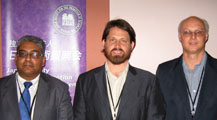Department of Political Studies and Governance involved in regional seminar on peace and security in Southern Africa
 |
Attending the Lusaka seminar was from the left: Prof. Hussein Solomon; Prof. Virgil Hawkins from Osaka University and main organiser of the seminar; and Prof. Theo Neethling.
26 September 2012 |
Two staff members from the Department of Political Studies and Governance, Prof. Hussein Solomon and Prof. Theo Neethling, were recently invited by the Osaka University in Japan to participate in a regional seminar in Lusaka, Zambia, on multinational peacekeeping and peace enforcement in Southern Africa.
The seminar was organised by the Southern African Centre for Collaboration on Peace and Security funded by the Japan Society for the Promotion of Science. Prof. Solomon presented a paper on the establishment of the Southern African contingent of the African Union’s African Standby Force, while Prof. Neethling presented his paper on United Nations peacekeeping operations in the war-ravaged eastern parts of the Democratic Republic of Congo.
The participation of Prof. Solomon, Senior Professor, and Prof. Neethling, Head of the Department of Political Studies and Governance, comes from a cooperation agreement between Osaka University’s School for International Public Policy (OSIPP) and the Faculty of Humanities at the University of the Free State. The agreement covers issues like joint collaboration projects, the exchange of staff and senior students and joint conferences. One of the key joint areas lay in the Southern African Centre for Peace and Security Studies, a consortium of several Southern African universities with Osaka University and the University of the Free State as its key pillars.
Other universities include the University of Zambia, Zambian Open University, University of Dar es Salaam, Mozambique-Tanzania Centre for Foreign Relations. Academics from other universities in the region, like Nzuzu University in Malawi, University of Botswana, University of South Africa, Stellenbosch University, University of Zimbabwe, are all in the network.